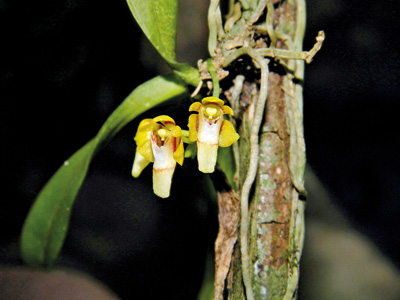News
Alarm over decline in Anuradhapura Orchid population; call to protect native beauties
The Anuradhapura orchid – Vanda Tessellata — is Sri Lanka’s most heavily traded indigenous orchid species but over the past two decades its population has been on the decline, an expert has raised alarm.

Dalaputtuwa orchid. Pic by Ishara Wijewardhane
“This orchid type is popular and their different colourations make them attractive. So, there is considerably a large demand for the flowers in the local and the export market. But the Vanda Tessellata population has heavily declined in the past 20 years due to the high demand and the lack of adequate conservation measures,” says the expert, Samantha Gunasekera, who was once the head of Sri Lanka Customs’ Biodiversity Protection Unit.
Vanda Tessellata is an indigenous orchid species found in the dry and intermediate zones of Sri Lanka. As it has many colour variations, it is attractive and more prone to collection. Most of Sri Lanka’s orchids are spread in the wet and montane zones, but the Anuradhapura orchid grows in Sri Lanka’s dry zone and intermediate zone.
Like other orchids, the Anuradhapura orchid is also protected under the Fauna and Flora Protection Ordinance and included in the Vulnerable (VU) category on the National Red List. However, the law enforcement regarding the species is very poor, laments Mr. Gunasekera.
He revealed that although Customs had busted only attempts so far to smuggle the Vanda Tessellata plant out of the country, with one of the detections being made by the Forest Conservation Department. He said seven illegal local sale sites had been raided and two local suppliers of Vanda Tessellata had been identified through their surveys.
Mr. Gunasekera revealed these facts at an event organised by the Orchid Circle of Ceylon at the Sri Lanka Association for the Advancement of Science (SLAAS) auditorium last month to celebrate its 85th anniversary. Established in 1934, the Orchid Circle of Ceylon (OCC) is the oldest organisation of its kind in Sri Lanka and the second in the world after the American Orchid Society. The Circle has a prestigious past with the founder President of the Orchid Circle of Ceylon being none other than Sri Lanka’s first Prime Minister, D.S. Senanayake.
“Sri Lanka has lots of orchid lovers, so we revived the Orchid Circle of Ceylon to encourage more people to take the hobby right way. We are happy about the response we received for our society’s 85th Anniversary,” OCC secretary Dr. Uditha Herath said. The event was also associated with an orchid show that displayed some rare orchids.
The event’s Chief Guest, Prof. Surawit Wannakrairoj from Thailand, delivering a lecture on the fertilizer use in orchid cultivation, pointed out that in Sri Lanka the fertilizer usage was high. Orchid expert Ajantha Palihawadana delivered a speech on conservation of wild orchids.
Sri Lanka is home to some 192 orchid species belonging to 78 categories and more than half of them are threatened according to the National Red List of Threatened Fauna and Flora of Sri Lanka 2012. Habitat loss remains the biggest issue for Orchid species with pollution, invasive species also contributing to their decline.
The direct exploitation where some of these orchids are fetched out from their habitat has been a bigger issue for a number of orchids, said Dr. Suranjan Fernando in the the 2012 National Red List publication. Those orchids commonly collected for their beautiful flowers include Phaius Wallichii (Star Orchid), Dendrobium Maccarthiae (Vesak Orchid), Rhynchostylis Retusa (Fox Tail), and Vanda Tessellata.
Habenaria Crinifera (Naarilatha), Ipsea Speciosa (Nagamaru Ala), Anoectochilus Spp (Wanaraja), Zeuxine spp (Iruraja) are removed from the wild for medicinal purposes and for various rituals associated with mythological beliefs, according to Dr.Fernando.

